TELLING SNOW
I Grow Taller
“Make hay while the sun shines” is fine advice in its season. For winter, how about? “Prune while the snow is high and firm.”
My apple and pear trees are semi-dwarf, presently ranging from seven to eleven feet tall. Even though I have a pole pruner and various long-reach pruning tools, I still carry my three-legged orchard ladder out to the trees with me to work on their upper branches. Sometimes you have to get your eyes and arms and hands right up near where you’re actually cutting.
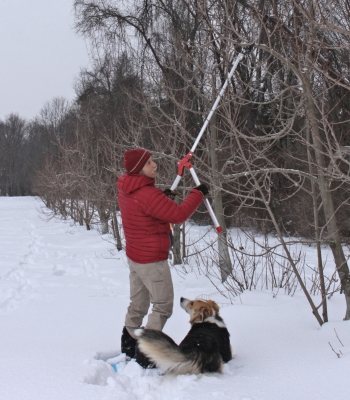
A few years ago, as I was looking out the window and admiring the foot or of snow on the ground, I realized that all that snow could give me a literal leg up on pruning. If I stayed on top of the snow, that is. While the snow was still soft, I was able to do this by strapping on a pair of snowshoes, which I bought, used, just for this purpose. (For travel through snow, I prefer to glide, on skis.) When the snow melted a little and then froze, the icy crust that formed was able to support my weight sans snowshoes.
In any case, when there’s a good depth on the ground, such as today, I gather my tools – minus the stepladder – and walk tall out to the trees.
Top Down Pruning
Plants, like other creatures, have hormones, and a hormone (called auxin) in every plant generally coaxes uppermost portions to grow most vigorously. Which is why old apple trees become topheavy, with most shoot growth high up. The upshot of this habit is that most fruit is borne high in the branches, out of reach, and lower branches are shaded to become unproductive and prone to disease.
Ideally, then, the best place to start pruning is with the most vigorous branches, highest in the tree. That’s also the last place you want to start if you’re standing at ground level. Perched atop a good depth of snow next to my smaller trees, starting near the top was much easier.
If I get high enough (in the tree), I can imagine that I’m hovering above the branches, looking at them from the perspective of ol’ Sol, which is a good perspective for a grower of fruit trees. This allows a more objective perspective on which branches are going to be blocking light or otherwise cramping others for space.

Letting more light and air in among the branches and, at the same time removing potential fruits with pruned branches, channels more of each tree’s energy into perfecting those fruits that remain. Remaining fruits are then healthier, larger, and more flavorful, especially for naturally larger fruits such as apples, pears, and peaches
Snow Tales
The snow is a blank canvas that records some winter activities. My dogs’ footprints are obvious and telling. They are provincial in their travels, having beaten paths from their doghouses, where they sleep, to the driveway, where they greet humanity, and to the deck, where they lie in the sun.
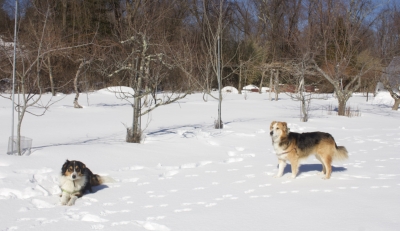
Daisy and Sammy at work
Less frequent are their forays out into the hay field to do their business and to see if anything interesting is creeping around out there.
The small, padded footprints of my cat hasn’t beaten out paths. The cat more randomly explores out-of-the-way nooks and crannies. She also likes to steer clear of the dogs, who consider her just another small animal worth chasing.
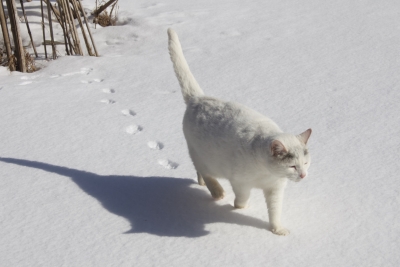
Gracie at work
The distinctive footprints that I’m keeping the closest eye out for are those of rabbits and deer. Now, about when I typically delude myself that all danger has past, periods of warmer weather start coaxing rabbits to wander about and eye my trees and shrubs as food. Now is also when cottontail rabbits start reproducing, the first of up to five litters for this year, with a half dozen or so bunnies per litter! Very cute, but deadly to my plants.
This winter, a couple of deep snows either brought deer here or displayed their abundance with tracks in the snow. For the rabbits, who feed on young trees and low branches, I sometimes make up a spray of white latex paint, water, eggs, cinnamon, and hot pepper. That needs to be re-applied about now. Traps I set out for them are thoroughly and safely (for the rabbits) buried in snow. Perhaps I’ll dig them out and re-set them.
The uncluttered expanse of snow makes it easy to see where I put my pruning tools as I prune the apples and pears. The snow also makes it easy to see where I drop the prunings.
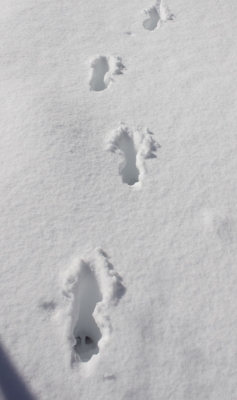
Deer tracks in the snow
And why do I care where I drop my prunings? Because I can then quickly look at them to see if any bark has been gnawed off those freshly cut branches. And what would gnaw bark off those freshly cut branches. Rabbits!
No sign of rabbits – yet, at least – on those prunings as well as on tracks in the snow. Thank you Gracie (my cat).
The dogs’ are supposed to be keeping deer at bay, but do so only if they are out and about when deer are around. This year I’ve been relying on Bobbex repellent, which I spray monthly on branches that would be within reach of the deer. So far, the sprays have been 100% effective even on trees with deer tracks right beside them in the snow.
Get Ready for Spring
I will be hosting a WEEDLESS GARDENING webinar on Monday, February 22nd for $35. It will run from 7-8:30 pm EST and there will be plenty of opportunity to ask questions. For details, go to www.leereich.com/workshops. Or trust me, and go right to registration (required) at https://us02web.zoom.us/webinar/register/WN_WqSCBtOGTqqjGgbOHOuxfg
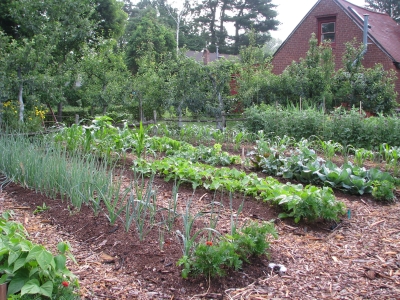

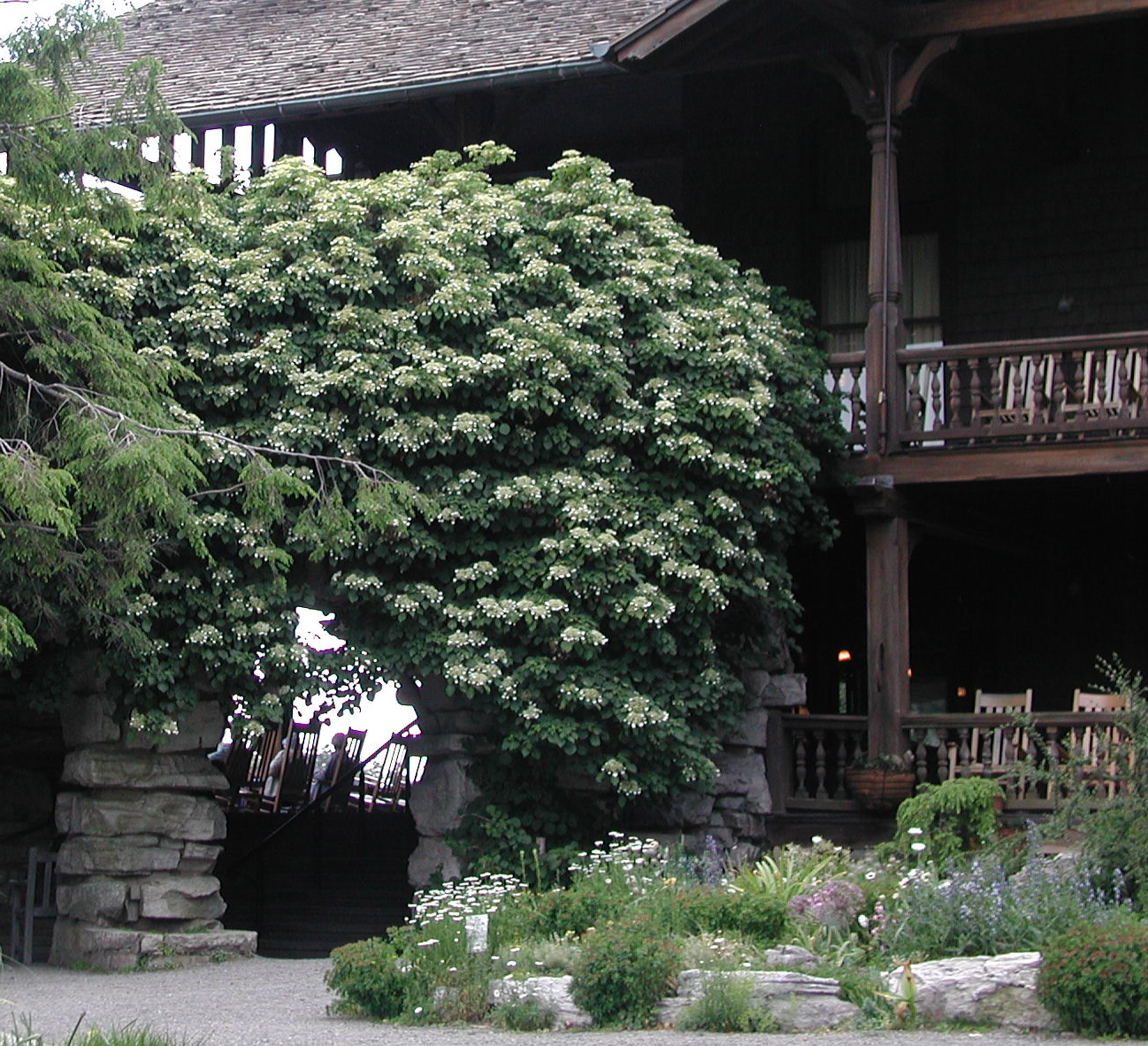

Love your blogs
Thank you!!!
We recently purchased a lot with a house and a few fruit trees and a walnut tree, that haven’t been maintained/pruned in a long while. Would the “pruning from the top down” be appropriate for these overgrown cherry trees as well as the walnut.
If the trees are overgrow, it’s probably best to over the course of 2-3 years, prune back one or more major limbs. That would let a lot more light and air in amongst the branches, but not too much all at once.
Would this be the time to trim (copic) my Kiwis to prepare them for transformation from bib wild=trunk to cordon form at my new T trellis (deliciosa) and protected pergola by the house (arguta). The peepers are singing and I planted snap peas yesterday.
Tes. Definitely. You must be in a lot warmer place than me, with peepers and pea planting. That’s early April for me here in Zone 5.
Thanks for Kiwi wisdom (sorry for my typos).
Additionally I am going to plant about 30 blueberries which are in 2 gallon pots in about 3 weeks. We plan to put them on an East slope into red lay soil. I was advised to dig a 2 ft diameter hole 2 ft foot deep then mix 50% sand and 50% ground aged pine bark mulch to fill the hole and mound up a foot or so above ground. Any thoughts? Thanks, Deloy
The only change I would make is to make the hole wider, 3 feet or more across. No need to dig 2 feet deep. About a foot should be sufficient. If the drainage of the clay is poor, you might want to raise the plants on a slight mound. And keep an eye out for nitrogen or iron deficiencies, as evidenced by leaf color.
Hi Lee– LOVE this post! (Especially because I am short) Can you please tell me about those pruners you’re using?
IT’S AN ARS brand tree lopper. ARS makes some of my favorite pruning tools. Check out the link to their site on my blog page.
Your blogs and books are fantastic.
Thank you. Glad you like them.
Lee thanks very much for this timely piece. Can you tell me the brand of the tree Lopper in your picture? I’ve been looking for an alternative to a my existing long pole with a cord.
IT’S AN ARS brand tree lopper. ARS makes some of my favorite pruning tools. Check out the link to their site on my blog page.
Hi Lee – thank you for your great blog posts! Just curious what have you found to be the best bait to trap rabbits? Since my cat passed away my yard is now overrun with bunnies! Ugh!!
Thank you!
gayle
They don’t read children’s books, so, for me at least, carrots have not worked. Usually. I’ve tried slices of apple, and spraying the trap with apple juice. But none of my efforts are always successful. Dogs and cats are much more effective.
Do you think your spray of white latex paint etc. would work for squirrels? They seem to like to chew bark on certain trees. My neighbor is feeding them, taming them and naming them!
The squirrels don’t eat branches or bark so there’s no need for the spray. It surely wouldn’t stop their travel on a tree. Ind they’d probably eat sprayed branches if they wanted to!
Was inspired to set up a compost bin by your class.
Have a half full geobin in my backyard, to which I add and mix regularly. It’s currently full of snow since it doesn’t have a lid. Will this slow the process? Anything else I can do to move things along?
Thanks, Fern Fried
Hi Fern, I’m not sure what a geobin is. But if the bin is full of snow it might go anaerobic, especially if there’s no way for the water to drain out. If there are no drainage holes, make some.